Dating apps have come a long way, but Web3 dating app development is taking things to a whole new level.
As users demand more privacy, ownership, and authentic connections, Web3 dating apps are gaining real momentum.
In fact, the Web3 market is expected to grow from $6.63 billion in 2024 to over $177 billion by 2033.
With features like decentralized identity, token rewards, and user-owned matchmaking algorithms, Web3 dating isn't just a trend– it's the next frontier.
If you’re looking to build a Web3 dating app, now’s the time to dive in and get ahead of the curve. Here's everything you need to know.
Let’s get started:
What is a Web3 Dating App?
A Web3 dating app is an application that is built on blockchain technology, offering different features including decentralized data storage, tokenized economies, and verifiable credentials.
It aims to provide a secure, private and user-centric dating experience by empowering users with huge control over their data and digital identity.
Gather is a perfect example of a Web3 dating app that stands out with its innovative identity verification system, helping to minimize bots and fake profiles.
Additionally, the app allows users to stake tokens and earn passive rewards for their engagement.
Overview of Web3 Market Stats
Web3 is no longer just hype– it’s a thriving movement. As per dating app stats, it is a growing phenomenon in this industry. Here’s a closer look at what the numbers are telling us.
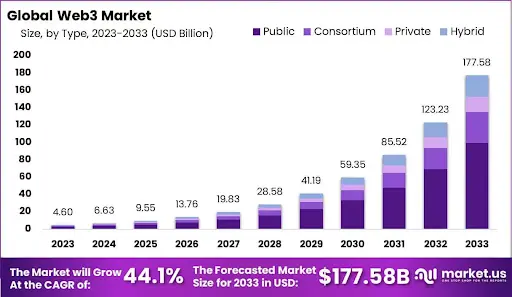
-
- The global Web3 market is expected to surpass USD 6.63 billion in 2024 and reach an impressive USD 177.58 billion by 2033, growing at a remarkable CAGR of 44.1% during the forecast period.
- In 2023, the public segment took the lead, capturing over 56% of the total Web3 market share.
- Payments emerged as the top application area, accounting for more than 35% of market share.
- Among industries, the BFSI sector dominated with a 23% share, followed by IT & Telecom, Media & Entertainment, Dating, E-commerce & Retail, Healthcare & Pharmaceuticals, and others.
The dating industry is evolving. Now people demand transparency, data control and a token-based experience.
As a result, Web3 dating app development is gaining serious momentum.
Startups are tapping into blockchain to reimagine matchmaking, making it safer, smarter, and more user-driven.
Why You Should Develop a Web3 Dating App?
Traditional dating apps? They're overcrowded, often untrustworthy, and ruled by platforms that monetize users without giving them anything back. A Web3 dating app flips that.
It’s not just about slapping blockchain on Tinder mechanics – it’s about rebuilding the dating experience with trust, ownership, and innovation at its core.
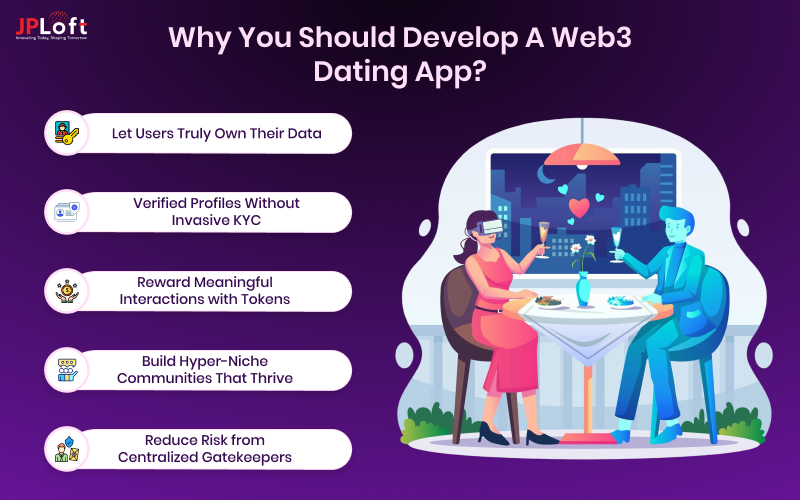
Here’s why more innovators and investors are betting big on Web3 dating app development:
1. Let Users Truly Own Their Data
When you develop a Web3 dating app, you’re flipping the script on data ownership. No more platforms hoarding information behind the scenes.
With blockchain, users control their profiles, matches, and messages– everything is transparent, secure, and user-owned. It’s a dating experience built on trust, not tracking.
2. Verified Profiles Without Invasive KYC
Nobody wants to upload a passport to prove they’re real.
By using decentralized identity (DID) tech, you can verify users in a secure, non-invasive way.
When you create a Web3 dating app with built-in trust systems, fake profiles and scams become a thing of the past.
3. Reward Meaningful Interactions with Tokens
Why should platforms make all the money off user engagement?
With token economies, users can earn rewards for quality interactions, like thoughtful messages or hosting events.
Web3 dating app development opens the door to loyalty systems that feel fair and fun, not extractive.
4. Build Hyper-Niche Communities That Thrive
Instead of cloning Tinder, imagine launching a dating app for NFT collectors, DeFi traders, or DAO founders.
Web3 lets you focus on community-first development, enabling powerful social bonds that grow naturally. You can build for people who share values, not just locations.
5. Reduce Risk from Centralized Gatekeepers
When you develop a dating app embedding Web3, you’re not at the mercy of Big Tech. No sudden bans, algorithm changes, or shutdowns.
You own the infrastructure, and that independence gives your app stability, longevity, and freedom to innovate.
How Web3 Dating Apps Address the Challenges of Web2?
If you're thinking of entering the world of developing a dating app, it’s time to explore how a Web3 approach can solve the problems that have held back traditional platforms.
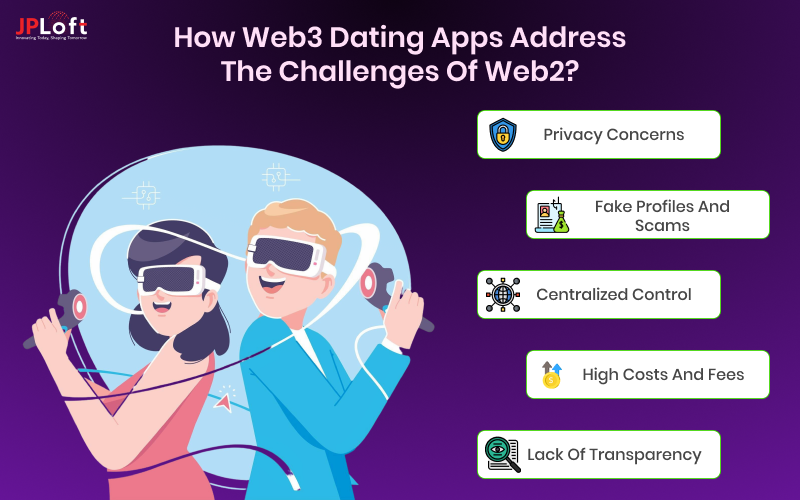
Here’s how a web3 dating app development can help you build something that truly meets the needs of current daters:
1] Privacy Concerns
Challenge: Your personal data is everywhere on Web2 dating apps, and you have no control over how it’s used or shared.
Solution with Web3: By using blockchain, you can create a Web3 dating app where your users' data is stored securely and anonymously, giving them full control over what they share and with whom. No more worrying about data breaches or misuse.
2] Fake Profiles and Scams
Challenge: Fake profiles and scams are rampant, making it hard to trust the people you meet online.
Solution with Web3: When you develop a Web3 dating app, the blockchain ensures transparency and authenticity. Users can verify their identities with tokens or NFTs, cutting out the fakes and building trust from the start. This solution directly addresses one of the major challenges of dating apps.
3] Centralized Control
Challenge: The platform controls everything, from who sees your profile to what content you can post.
Solution with Web3: Building a Web3 dating app allows for decentralization, meaning your users are in charge. They can choose who interacts with them, what they see, and how they engage. You don’t control their experience; they do.
4] High Costs and Fees
Challenge: Traditional dating apps often charge high subscription fees or take a large chunk of the revenue from in-app purchases.
Solution with Web3: With a Web3 dating app, you can eliminate unnecessary middlemen and reduce fees. This creates a more affordable platform for users while increasing their satisfaction.
5] Lack of Transparency
Challenge: Users often feel like they don’t know what happens to their data or how it’s being used by the app.
Solution with Web3: By creating a Web3 dating app, transparency is built into the system. Smart contracts and decentralized networks ensure users understand how their data is used, giving them peace of mind.
As we have explored the need to build a Web3 dating app, it’s now time to understand key features that can separate your app from your rivals:
Essential Features to Have in Your Web3 Dating App
When it comes to building a Web3 dating app, we believe that features are something that users look forward to.
To help you out with the best, here is a list of the best features of dating apps you can consider:
|
Feature |
Description |
|
Decentralized Identity Verification |
Blockchain-based verification system that ensures users can authenticate their identity while maintaining control over their personal data. |
|
Token-Based Rewards System |
A reward system that uses tokens to incentivize user engagement and activity. Tokens can be used for premium features or exchanged for other benefits. |
|
Smart Contracts for Transparent Transactions |
Use blockchain smart contracts to automate and secure payments, subscriptions, or memberships, ensuring transparency and eliminating middlemen. |
|
NFT-Based Profile Customization |
Allow users to own and display unique digital assets (NFTs) on their profiles, showcasing their individuality and enhancing user experience. |
|
End-to-End Encryption |
Implement encryption to secure all user data, conversations, and media shared, protecting privacy and preventing unauthorized access. |
|
Location-Independent Matching |
Enable global matchmaking based on interests or preferences, removing geographic barriers and using blockchain algorithms to create meaningful connections. |
|
Customizable Privacy Settings |
Users can control who sees their information and interactions, ensuring a secure and private online dating experience. |
|
Decentralized Governance |
Let users participate in the decision-making process of the app through governance tokens, allowing them to vote on features, updates, and policies. |
With this being shared, somewhere, the curiosity of how to create a web3 dating app still remains the same. Let’s find that out in the next section:
How to Develop a Web3 Dating App?
Ready to create a Web3 dating app that stands out?
The Web3 dating app development process blends blockchain, security, and user engagement in innovative ways.
Learn how to build a Web3 dating app that’s decentralized, secure, and offers a unique experience.
Step 1: Define Your Unique Selling Point (USP)
When you're thinking about how to create a Web3 dating app, the first step is defining what makes it unique.
Is it the privacy that users get with blockchain technology? Or maybe the ability for users to own their data and identities? Whatever it is, make sure it resonates with your target audience.
This USP will be the foundation of your app’s branding and user engagement.
Don’t just follow trends– become the trendsetter!
Step 2: Design a Seamless User Experience (UX)
Building a Web3 dating app means focusing on an intuitive, fun, and fluid user experience.
Users should have an easy time navigating through the app, creating profiles, swiping, chatting, and setting preferences.
Think about how to make a Web3 dating app that feels like a natural, fun part of their daily life.
The answer will be a smooth dating app design.
Keep it simple but engaging. The smoother the UX, the more users will stick around.
Step 3: Choose the Right Blockchain Technology
Choosing the correct blockchain is vital in the Web3 dating app development process.
You might be tempted to go with Ethereum due to its popularity, but other options like Polygon, Binance Smart Chain, or Solana could provide faster and cheaper transactions.
Make sure the blockchain you pick supports decentralized features and offers scalability.
After all, the right technology behind your app will ensure it works smoothly and securely.
Step 4: Prioritize Privacy with Decentralized Identity
Privacy is everything in the Web3 world. Users want full control over their data.
Integrate decentralized identity features so users can securely verify themselves without sharing unnecessary details.
This allows them to interact on the platform while keeping their personal data private.
By focusing on how to develop a Web3 dating app that puts privacy first, you build trust and loyalty among your users.
Step 5: Reward Engagement with Tokens
Adding token-based rewards is a fun way to keep your users active.
Let them earn tokens for actions like swiping, chatting, or even just daily logins.
These tokens could unlock premium features, special boosts, or exclusive content, adding an extra incentive to stay engaged.
This tokenization model keeps your app fresh and exciting while also adding value for your users.
Step 6: Integrate Smart Contracts for Transparency
Smart contracts are one of the most powerful features of Web3 dating app development.
They can be used for everything from subscriptions and in-app purchases to premium features, all automated for transparency.
Users can trust that everything is handled securely and fairly, without hidden fees.
In the dating world, trust is essential, and smart contracts will give users peace of mind about how their money is spent.
Step 7: Personalize Profiles with NFTs
Let users stand out by integrating NFTs for profile customization.
Think about giving users the ability to collect unique, digital items, such as badges, avatars, or relationship milestones.
These NFTs could be used to showcase personality traits or achievements in their dating journey.
It’s a cool way to create a more personalized experience and bring Web3 to life in your dating app.
Step 8: Beta Testing and Real-World Feedback
Before your Web3 dating app hits the public, run beta testing.
Invite real users to test the features, the matchmaking algorithms, and wallet integrations.
Get feedback on the user experience and fix any bugs or issues that arise.
Beta testing helps you iron out any kinks and ensures that when you do launch, everything works as smoothly as possible.
Step 9: Launch and Market Your Web3 Dating App
Once everything is set, it’s time to launch your app on submit your app on App Store or publish your app on Play Store!
Use social media, influencers, and blockchain communities to create buzz around your Web3 dating app.
Highlight what makes your app different, like enhanced privacy, token rewards, and NFTs.
By targeting the right audience and emphasizing your app’s unique features, you can quickly build a user base that’s excited to get started.
Step 10: Keep Evolving with Web3 Trends
To ensure your Web3 dating app remains relevant, keep an eye on the latest Web3 & dating app trends.
Integrate new features that make your app more fun, interactive, and secure.
Stay updated with new blockchain networks, DeFi developments, and user expectations to keep evolving.
This is how you can launch a new Web3 dating app, moving forward the next section will help you know the investment required:
How Much Does it Cost to Develop a Web3 Dating App?
So, you're thinking of building a Web3 dating app– that’s exciting! But before diving into the world of decentralized matchmaking, let’s talk about one important thing: the cost of your dating app.
So, how much does it cost to build a Web3 dating app?
The overall Web3 dating app development cost typically ranges between $50,000 to $150,000+, depending on the complexity of features, blockchain integration, and design requirements.
Now, there’s no across-the-board answer because a lot depends on the features you want, the complexity of the app, and the team you hire.
From blockchain integration to NFT profiles and token rewards, each unique feature will influence your cost to develop a Web3 dating app.
It’s kind of like dating: the more features you add, the more you're investing in a truly unique experience.
Here’s a snapshot of what to expect when figuring out the cost to create a Web3 dating app:
|
Feature |
Estimated Cost |
Description |
|
Basic App Development |
$20,000 - $30,000 |
Simple app with basic matching and chat features. |
|
Blockchain Integration |
$10,000 - $30,000 |
Adding decentralized identity and blockchain-backed privacy. |
|
Token-Based Reward System |
$5,000 - $15,000 |
Implementing a system where users earn tokens for activity. |
|
NFT Profile Customization |
$7,000 - $20,000 |
Creating NFTs for avatars, badges, or other digital collectibles. |
|
Smart Contract Development |
$10,000 - $25,000 |
Writing secure smart contracts for premium features and transactions. |
|
UI/UX Design |
$8,000 - $20,000 |
Ensuring a smooth, intuitive, and fun user experience. |
|
Beta Testing & Feedback |
$3,000 - $10,000 |
Gathering user feedback to refine and improve the app. |
Depending on your vision, the cost of Web3 dating app development can fluctuate. But, no matter what, the investment will pay off as you’re stepping into the future of dating.
So, if you want a game-changing, decentralized experience, prepare for a little sticker shock. It’ll be worth it!
How Web3 Dating Apps Make Money?
So, you're probably wondering, "How do Web3 dating apps make money?" It’s a valid question, especially when you’re diving into the world of decentralized, blockchain-powered matchmaking.
The dating app monetization model is evolving, especially with Web3 in the mix.
Don’t worry, Web3 dating apps still have plenty of ways to turn a profit without relying on traditional, intrusive ads. Let’s talk about it!
1. Premium Subscriptions
Just like in Web2 dating apps, Web3 apps offer premium features. Think of it as VIP status in the dating world.
With premium subscriptions, users can access advanced matchmaking algorithms, more visibility, or even boost their profiles to be seen by more potential matches. It’s all about exclusivity.
2. Token-Based Rewards and Purchases
If you’re thinking about how to develop a Web3 dating app, consider integrating a token economy.
Users can earn tokens through engagement, like swiping or chatting, and use them to unlock special features. It’s a way to keep users motivated and create an interactive, rewarding experience.
3. NFT Sales and Collectibles
Want to really get creative? When you create a Web3 dating app, NFTs can become a major revenue source.
Offering users unique digital items – like profile badges, avatars, or custom NFTs for milestones – can help monetize the platform in a fun, collectible way.
The best part? These NFTs can be traded and sold, creating a community-driven marketplace.
4. Smart Contract-Enabled Transactions
Thanks to smart contracts, Web3 dating apps can automate transactions like membership renewals, token purchases, or event bookings.
The beauty of it? It’s secure, transparent, and cuts out the middleman, so apps don’t need to rely on third-party platforms to process payments.
5. Ad-Free Experience With Blockchain Incentives
Instead of bombarding users with ads, Web3 dating apps often focus on a seamless, ad-free experience.
Your app can monetize by offering users the option to stake tokens or participate in blockchain-based incentives, like earning rewards for regular app usage.
This keeps the experience smooth while still making money.
6. Affiliate Marketing & Partnerships
Some Web3 dating apps leverage affiliate marketing and partnerships to earn revenue.
For example, they may partner with businesses in the crypto, lifestyle, or fashion industries and offer users special deals or promotions.
If you take the bait and make a purchase, the app earns a commission.
7. Virtual Gifts and Experiences
Just like the digital gifting trend in other platforms, Web3 dating apps offer users the chance to send virtual gifts to their matches.
Think of it as a digital bouquet of flowers but with tokens and NFTs! These experiences can be monetized while enhancing user engagement.
Future Trends in Web3 Dating App
The world of dating is evolving, and Web3 is leading the way.
With blockchain technology at its core, dating apps are transforming from basic matchmaking platforms to immersive, user-controlled experiences.
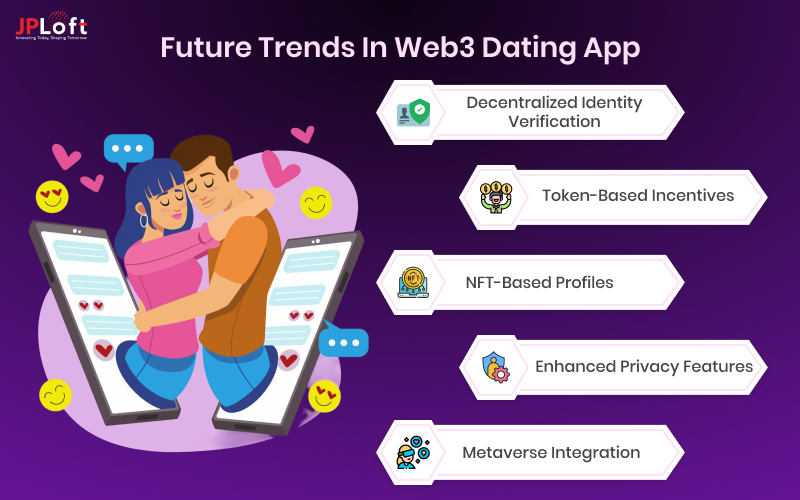
Let’s dive into the exciting trends of dating apps that are shaping the future:
► Decentralized Identity Verification
Gone are the days of relying on centralized platforms to validate your identity.
With Web3 dating apps, decentralized identity verification allows users to maintain control over their data.
It’s a huge step forward in preventing catfishing and ensuring authenticity in the digital dating world.
► Token-Based Incentives
Imagine being rewarded just for using a dating app-- sounds cool, right?
Web3 dating apps incorporate token-based systems where users can earn rewards for swiping, chatting, and engaging on the platform.
Tokens unlock premium features and even allow users to trade for other perks, keeping things fun and motivating.
► NFT-Based Profiles and Customization
Want your profile to stand out? Web3 dating apps are letting users create unique, NFT-powered profiles.
You could own exclusive digital assets like badges or avatars that showcase your personality.
It’s like personalizing your dating experience with digital art– an exciting way to express yourself!
► Enhanced Privacy Features
Privacy is everything, and Web3 dating apps are putting the power back in your hands.
With blockchain’s decentralized nature, you have control over your personal data.
No more third-party data collectors or unwanted ads– just complete privacy and transparency. It's the next level of safe online dating.
► Virtual Dates and Metaverse Integration
As Web3 continues to grow, the boundaries of online dating are stretching.
Virtual dates in the metaverse are becoming a reality, where you and a match can meet in a digital world.
This immersive experience allows users to connect in new ways, making long-distance relationships feel closer than ever.
How JPLoft Can Help You Build a Web3 Dating App?
Imagine a dating platform where users truly own their data, where every match is secured, and fake profiles are a thing of the past.
That’s the power of Web3, and building such a transparent and trust-first dating experience needs the right tech partner.
JPLoft, the best dating app development company, can help you create a Web3 dating app that redefines online connections.
From NFT-based identity verification to smart contract-driven subscriptions and tokenized rewards, we turn futuristic dating concepts into real-world platforms- secure, scalable, and ready for global adoption.
Let’s build the future of dating together.
Conclusion
The dating landscape is rapidly evolving, and Web3 technology is paving the way for a more secure, transparent, and user-empowered future.
By integrating blockchain, decentralized identity, smart contracts, and token economies, Web3 dating apps offer a refreshing alternative to traditional platforms riddled with privacy issues, fake profiles, and centralized control.
Whether you're an investor looking to back the next big thing or a founder planning to develop a Web3 dating app, this is your window of opportunity. With the Web3 market projected to explode over the next decade, getting ahead now means tapping into a high-growth, innovation-driven space.
If you’re serious about building a Web3 dating app that stands out-- one that users trust, enjoy, and engage with-- partnering with the right development team is key.
FAQs
Gen Z values authenticity and privacy. Traditional dating apps feel transactional, algorithm-driven, and lack emotional connection. Many prefer real-life interactions, niche communities, or newer platforms like Web3 that offer more control and transparency.
Web3 apps earn through tokenomics, NFT sales, staking rewards, premium features, and decentralized ad models. Some also monetize by offering exclusive DAO memberships or transaction fees on in-app activities.
Yes – Web3 can be highly profitable. With growing demand for decentralization, creators and early adopters benefit from token value appreciation, NFT revenue, and reduced platform fees due to peer-to-peer structures.
Start by defining your use case, then choose a blockchain (like Ethereum or Polygon), design a smart contract, and integrate a wallet. Hire Web3 developers or a full-stack team to ensure secure, scalable development.
Absolutely. With the global online dating market worth of billions, a well-targeted, feature-rich app – especially with niche appeal or Web3 integration – can attract users, boost engagement, and generate steady subscription or in-app revenue.





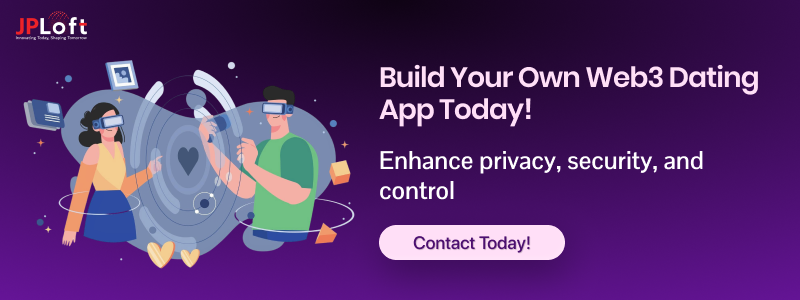

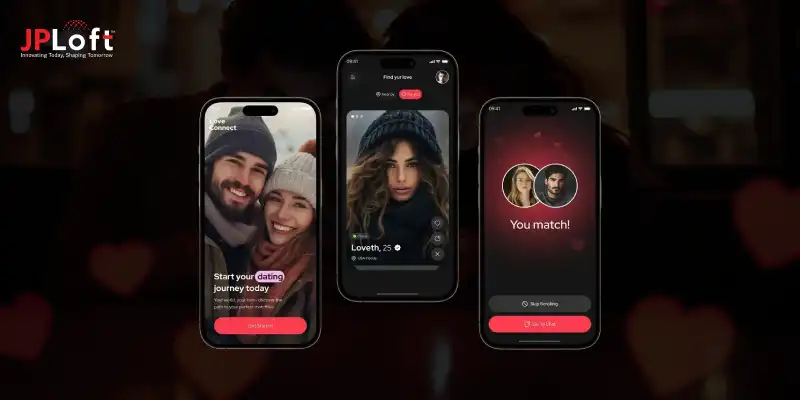

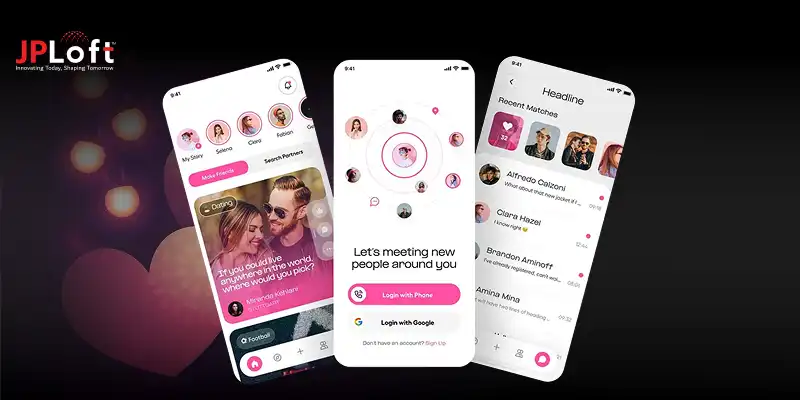


Share this blog